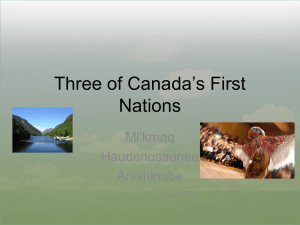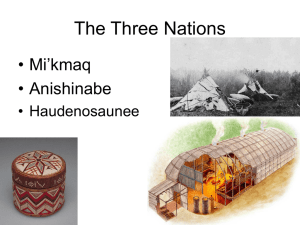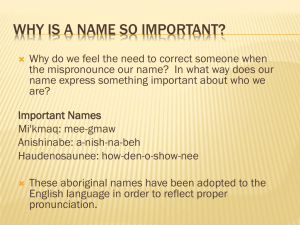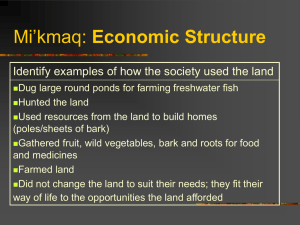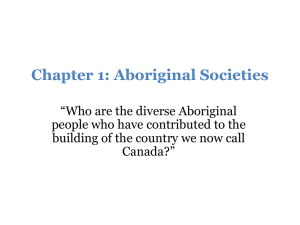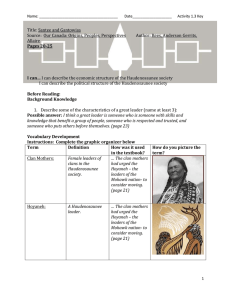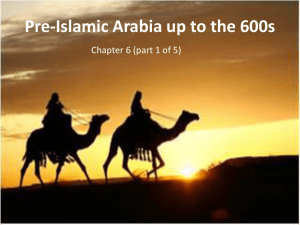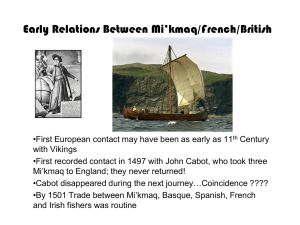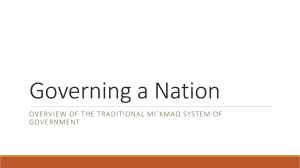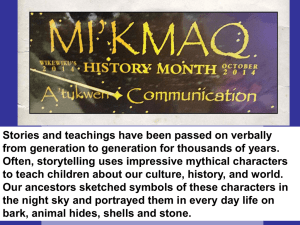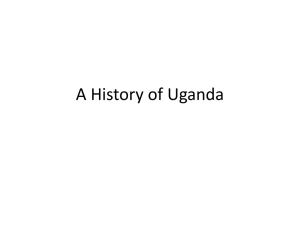Social Studies 7-Canada:Origins, Histories and Movement of Peoples.
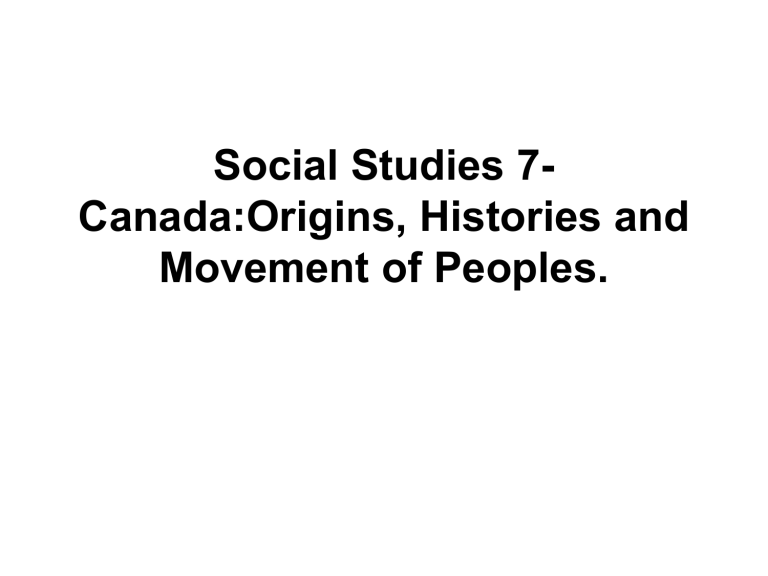
Social Studies 7-
Canada:Origins, Histories and
Movement of Peoples.
Perspective:
• values and ideas shared by people with a common language, culture and history.
Active Citizenship
– Active citizenship means many things. It means learning about what’s going on in your community, your country and in the world. It means working together with other people for a common goal. It means stepping up to support your community.
Introduction: The First Peoples
• There are no written records to tell us about the early societies of the First Peoples. Yet we know a great deal about these ancient cultures. Artifacts (an object made by human activity) left behind from earlier times tell us many things. We know about the housing in which people lived, the clothes they wore, and the tools they used. But there is much more to the past than material things. To learn about the culture and values of the First
Peoples, we must listen to the stories told by the Elders.
These stories have been passed down from generation to generation.
1. What are the different theories about when and how the
First Peoples came to live in North America?
• There are different theories about when and how the
First Peoples came to live in North America. They include:
• A) Most historians believe they crossed over from Asia on an ancient land bridge that existed during the ice age.
• B) Other historians think the First Peoples arrived here by boat across the Pacific Ocean.
• C) Still other historians think that some of the First
Peoples crossed the Atlantic Ocean to get here.
• D) Aboriginal peoples have another point of view. They believe they have been here since time began.
A culturally Diverse Land
• The First Peoples created many distinct societies. Each culture was unique with its own values and traditions. Long beforre
Europeans knew it existed, North America was one of the most culturally diverse lands the world had ever known.
The Mi’kmaq (background)
• The Mi’kmaq lived and continue to live in what is now eastern Canada. The Mi’kmaq lived in the woodlands and along the seacoasts. They lived in small villages of extended families called clans. The clan system helped the people cooperate. It also allowed them to live together in harmony and organize the sharing of resources.
The Mi’kmaq
2. How many districts were included in the
Mi’kmaq government?
3. What were the district leaders called and how were they chosen?
4.(a) How often did the Grand Council meet?
(b) What did the Grand Council do?
5. Why did the Mi’kmaq live close to the coast in summer and away from the coast, in the forest, in winter?
2. The Mi’kmaq government was organized around seven districts.
3. The local leaders were called Sagamaws and were chosen by a council of elders.
4.(a) The seven districts of the Grand Council usually met once a year.
(see diagram)
(b) The Grand Council advised Mi’kmaq communities where they could hunt, fish, and set up camps. It also managed relations with other
First Nations.
5. This seasonal movement allowed them to make the best use of the resources of their land. In summer they fished and hunted sea mammals such as whales. In winter they hunted animals of the forest such as moose.
Making Decisions (Mi’kmaq)
• Mi’kmaq leaders did not tell people what to do. In
Mi’kmaq society, leaders were chosen for their ability to reach agreement among people. The councils would listen to all the men and women who wanted to express an opinion on an issue. Then everyone discussed the issue until all members of the council agreed on what to do. This is called decision making by consensus.
The Anishinabe (background) and
World View
• The Anishinabe lived in the wooded of northern and central Ontario and in southern Manitoba. The
Europeans called them “Ojibway” or “Saulteaux”, but the people called themselves Anishinabe, meaning “the people”.
• In order to understand the Anishinabe culture, it is important to understand that they try to live their lives according to seven main values: wisdom, love, respect, bravery, honesty, humility, and truth.
Making Decisions (Anishinabe)
• Each of the clans had a leader, who was chosen because he displayed courage, good character, or skill in hunting. The leaders of the Crane and Loon clans were responsible for making decisions that affected all the people of the community. They worked together to create a balanced government. In times of conflict between the Cranes and the Loons it was the role of the
Fish clan to settle disputes.
6. What was the purpose of the Anishinabe Dodems
(clans)?
7. How was it decided which clan a person belonged to?
8. List and give the duties of each of the Anishinabe clans.
9.(a) What was Midewin Society?
(b) How were people chosen to enter Midewin Society?
(c) What did the Midewin do?
6. The clans worked together to provide balance and order in society.
7. A person became a member of his or her father’s clan.
8. The clans and there duties were:
Crane/Loon – leadership
Fish – Teaching/settled disputes
Bear – policing
Hoof – Community needs
Marten – Defense
Bird – Spiritual needs
9.(a) The Midewin were men and women who had special gifts as spiritual leaders and healers
(b) The Midewin chose their members very carefully, and once chose, a person entered into eight levels of secret training.
(c) The Midewin taught their society the importance of living a good life. They used medicines to heal sick people, interpret dreams and visions, and passed on sacred teachings and songs.
The Haudenosaunee: Background
The Haudenosaunee are a group that includes six different first nations: Mohawk, Oneida, Onondaga,
Cayuga, Seneca, and Tuscarora. At different periods in their history they lived either to the north or south of the
St. Lawrence River. While these six nations shared a similar language they each had a distinct culture. The
Haudenosaunee hunted and fished and gathered nuts, roots , and berries. The soil was fertile and the climate mild where they lived. This allowed them to become one of Canada’s first Farming peoples.
* The Haudenosaunee was a matrilineal society. This means that the head of each longhouse was a woman.
She was known as the Clan Mother .
Making Decisions
(Haudenosaunee)
Haudenosaunee women played an important role in government. Although the leaders were usually men, the Clan Mothers chose them.
Women could veto any law the men passed.
They could remove the men from leadership and replace them.
Each of the six nations sent leaders to take part in a central council. The council consisted of 50 leaders chosen by the Clan Mothers. The council met at least once a year and issues were decided by consensus.
10. Describe the Great Law of Peace.
11. What did the Grand Council do?
12. Who were the Hoyaneh and how were they chosen?
13. Describe the role of the Clan Mothers.
10. Dekanawidah – the Peacemaker – brought the
Great Law of Peace to the Haudenosaunee. The
Great Law of Peace created a confederacy of first five and eventually six nations. The Great
Law of Peace set down rules of government, in which each member nation of the confederacy had equal voice and status.
11. Decisions of the confederacy were made by a council of fifty chiefs.
12. The Hoyaneh were the chiefs of the grand council. They were chosen by the clan mothers.
13. The clan mothers were powerful people.
They chose the Hoyaneh. If a Hoyaneh failed to perform his official duties in accordance with the Great Law of Peace, the clan mothers could replace them.
